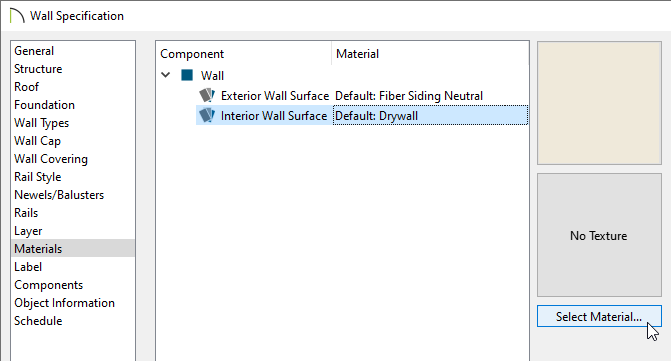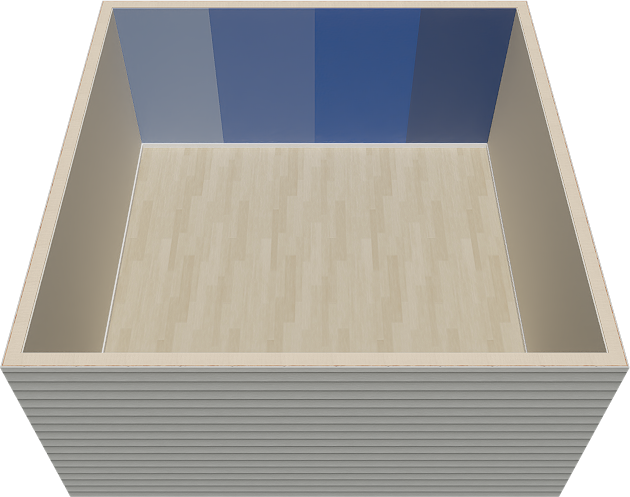QUESTION
I want to change the color of a single wall in my room to create an accent wall. How can I change the color of just a single wall?

ANSWER
An individual wall's color or material can be adjusted using either the Wall Specification dialog or the Material Painter tool.
To change the color or material of a single wall using the Wall Specification dialog
- Select the wall you'd like to change the material of, then select the Open Object
 edit button.
edit button.
- In the Wall Specification dialog that appears, select the Materials panel.

- Click on either the Interior or Exterior Wall Surface component, then click on the Select Material button.
- In the Select Material dialog that opens next, choose your desired color or material, then click OK.
- Click OK once again to close out of the dialog and confirm the change.
- Take a Camera
 view to see the results.
view to see the results.
To change the color or material of a single wall using the Material Painter
- Select View> Library Browser
 to display the Library Browser if it's not already open.
to display the Library Browser if it's not already open.
-
Select 3D> Create Perspective View> Perspective Floor Overview
 so that you can see the wall you wish to apply a different color or material to.
so that you can see the wall you wish to apply a different color or material to.
- To ensure that only a single wall is changed during this process, navigate to 3D> Material Painter and make sure that the Material Painter Component Mode
 is selected.
is selected.
There are a variety of different Material Painter Modes. Each mode specifies how broadly or narrowly the selected material will be applied to surfaces in your plan. In addition to the Material Painter Modes, the Blend Colors With Materials option allows you to apply a solid color to a surface displaying a pattern or texture and blend the two. Please see the Related Articles section below for more information on these tools.
- While in the 3D camera view, access the Library Browser
 , search for the color or material you wish to apply to a single wall, select it, then bring your cursor into the 3D view to see the Material Painter icon
, search for the color or material you wish to apply to a single wall, select it, then bring your cursor into the 3D view to see the Material Painter icon  .
.
- Click on a wall to apply the selected color or material to the wall.
In some cases, such as when an exterior wall runs the length of several rooms, or you want to apply different colors or materials to several different sections of the same wall to create a striped effect, you can use break points.

If you are in a 3D camera view, return to your 2D floor plan view for the following steps.
To change the color or material of a section of wall vertically
- To break a wall into segments, select the wall you want to modify, click the Add Break
 edit button on the Edit toolbar, then click on the wall to place the break point.
edit button on the Edit toolbar, then click on the wall to place the break point.
In legacy versions, use the Break Wall  tool instead.
tool instead.
-
After you have placed break points to create separate wall segments, use the instructions in the sections above to change the color or material on just that section of the wall.
If you notice that collinear wall segments are rejoining when you attempt to adjust the length of one or more segments, consider disabling this automatic behavior on a temporary basis. This can be done within the General Wall Defaults by navigating to Edit> Default Settings, expanding the Walls category, selecting General Wall, then clicking Edit; uncheck the "Auto Merge Collinear Walls" option, then click OK and Done.

Another solution would be to draw a Wall Material Region  in the desired area, though this adds more than just a color to the pre-existing wall surface, and is better suited for facade walls. Please see the Related Articles section below for information on Material Regions.
in the desired area, though this adds more than just a color to the pre-existing wall surface, and is better suited for facade walls. Please see the Related Articles section below for information on Material Regions.
To restore the default color or material
- On the Materials panel of the Wall Specification dialog for the wall that you'd like to restore the default material to, click on the desired component, then click on the Select Material button.
You can also navigate to 3D> Material Painter> Material Painter  in a 3D view to restore the default material.
in a 3D view to restore the default material.
- In the Select Material dialog that appears next, check the Use default material box, then click OK.
- The default material will be restored to the selected wall, however, if you selected the Material Painter tool in Step 1, you will also need to click on the wall that you want to apply the default material to.




![]() in the desired area, though this adds more than just a color to the pre-existing wall surface, and is better suited for facade walls. Please see the Related Articles section below for information on Material Regions.
in the desired area, though this adds more than just a color to the pre-existing wall surface, and is better suited for facade walls. Please see the Related Articles section below for information on Material Regions.